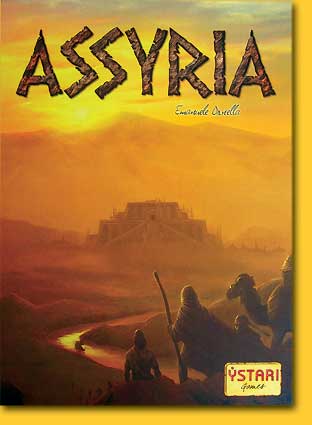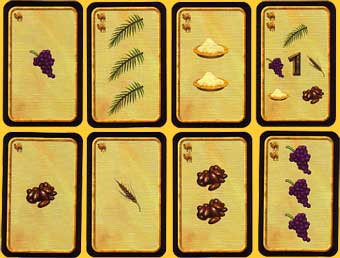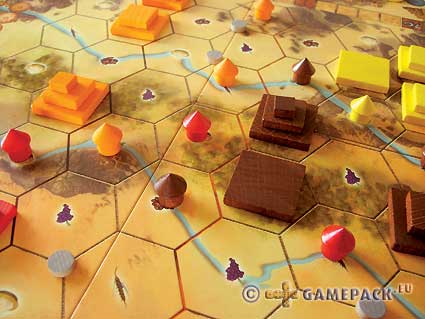Assyria
Author: Emmanuele Ornella
Publisher: Ystari / Asmodee
Year: 2009
review by

| x |
|
|
|
|
|
|
|
|
|
|
|
|
|
|
|
|
|
|
|
|
|
|
|
|
|
|
|
|
|
|
|
|
|
|
|
|
|
|
|
|
|
|
|
|
|
|
 |
Nomadic tribes attempt to settle in the unfriendly climate in North-Mesopotamia. Drought forces them to stay in the vicinity of rivers and build wells to supply them with drinking water. But from time to time the rivers flood, and they have to start all over again... Whoever manages to survive and even flourish under these harsh conditions may call himself victor!
|
|
|
The game lasts three reigns, each lasting two or three rounds. The board depicts a desert, divided into hexagons, separated by two rivers. Each hexagon depicts a food symbol that indicates what type of food the settlement on this hexagon demands.
|
|
| x |
|
|
|
|
|
|
|
|
|
|
|
|
|
|
|
|
|
|
|
|
|
|
|
|
|
|
|
|
|
|
|
|
|
|
|
|
|
|
|
|
|
|
|
|
|
|
 |
| Each round, multiple sets of two food cards are revealed, one set more than the number of participating players. The cards are arranged from left to right in ascending order according to the number of food symbols depicted. Players each choose a set of cards in turn order, and this automatically determines the turn order for the rest of the round: the player with the least favourable set of cards (few symbols) becomes starting player, and the player with the most favourable cards (many symbols) plays last. |
|
| x |
|
|
|
|
|
|
|
|
|
|
|
|
|
|
|
|
|
|
|
|
|
|
|
|
|
|
|
|
|
|
|
|
|
|
|
|
|
|
|
|
|
|
|
|
|
|
 |
Subsequently the players expand their domain by placing two to four new huts on the boards. Huts are placed on a hexagon adjacent to one of their own huts or ziggurats (a temple tower).
|
|
| x |
|
|
|
|
|
|
|
|
|
|
|
|
|
|
|
|
|
|
|
|
|
|
|
|
|
|
|
|
|
|
|
|
|
|
|
|
|
|
|
|
|
|
|
|
|
|
|
After this the players supply their huts with food, by discarding food cards showing the symbol corresponding with the symbol on the hexagon where the hut is positioned. Huts that cannot be supplied are removed from the board immediately! All remaining huts score victory points: one point for each hut outside the two rivers, two points for huts between the two rivers, and the huts on the rivers yield camels (cash). Each ziggurat level also scores one point, and wells, which can be built on the intersection of three hexagons occupied with huts, yield six to four points.
|
|
 |
|
| x |
|
|
|
|
|
|
|
|
|
|
|
|
|
|
|
|
|
|
|
|
|
|
|
|
|
|
|
|
|
|
|
|
|
|
|
|
|
|
|
|
|
|
|
|
|
|
 |
|
The expansion phase is followed by the action phase: the players take turns spending their camels. Possible actions are building a ziggurat on a hexagon occupied by your own hut, adding a second or third floor to a ziggurat, gaining influence with the local dignitaries, offering to the gods, and purchasing food cards.
After two or three rounds the reign ends, and a flood takes place. All huts on a river hexagon are removed from the board. Subsequently the players pay a visit to the dignitaries: the player with the most influence gets a lot of points, the second player a bit less et cetera. For each dignitary, additional bonuses are awarded: victory points, a food card, or a camel. The offering to the gods has not been in vain either: depending on the position on the offering track, players multiply their number of ziggurats with 1 to 4, and adjust their victory point marker accordingly. The player with the most victory points after three reigns wins the game! |
|
| x |
|
|
|
|
|
|
|
|
|
|
|
|
|
|
|
|
|
|
|
|
|
|
|
|
|
|
|
|
|
|
|
|
|
|
|
|
|
|
|
|
|
|
|
|
|
|
| x |
|
|
|
|
|
|
|
|
|
|
|
|
|
|
|
|
|
|
|
|
|
|
|
|
|
|
|
|
|
|
|
|
|
|
|
|
|
|
|
|
|
|
|
|
|
|
| x |
|
|
|
|
|
|
|
|
|
|
|
|
|
|
|
|
|
|
|
|
|
|
|
|
|
|
|
|
|
|
|
|
|
|
|
|
|
|
|
|
|
|
|
|
|
|
 |
|
|
|
|
|
|
|
|
|
|
|
|
|
|
|
|
|
|
|
|
|
|
|
|
|
|
|
|
|
|
|
|
|
|
|
|
|
|
|
|
|
|
|
The first and foremost attribute that lacks in Assyria is a player aid; most information is present on the board somewhere, but you keep searching all over the place. Bribing the first dignitary costs four camels but results in three influence points. The four camels are clearly depicted on the board, but the '3' is craftily disguised in the dignitary's dress: confusion guaranteed. It does not help that many things are not intuitive. Wells may not be constructed between the rivers, while ziggurats may; wells may not be constructed next to a ziggurat and vice versa, but wells can be built adjacent to wells, and ziggurats adjacent to ziggurats, are you still there?? Additionally, the starting positions are not depicted on the board; they are different for each player number, and have to be looked up in the rulebook.
|
|
| x |
|
|
|
|
|
|
|
|
|
|
|
|
|
|
|
|
|
|
|
|
|
|
|
|
|
|
|
|
|
|
|
|
|
|
|
|
|
|
|
|
|
|
|
|
|
|
 |
|
| x |
|
|
|
|
|
|
|
|
|
|
|
|
|
|
|
|
|
|
|
|
|
|
|
|
|
|
|
|
|
|
|
|
|
|
|
|
|
|
|
|
|
|
|
|
|
|
|
The huts also cause a lot of hassle; first, they have to be placed on the hex in such a way that the food symbol is still visible to all players, which is practically impossible to achieve. After supplying the huts, they have to be placed on the symbols, to indicate that these huts have been paid for, and this is inconvenient if you want to plan your next turn, and need to know which food cards you will need in the next round.
|
|
| x |
|
|
|
|
|
|
|
|
|
|
|
|
|
|
|
|
|
|
|
|
|
|
|
|
|
|
|
|
|
|
|
|
|
|
|
|
|
|
|
|
|
|
|
|
|
|
|
Apart from these design related matters, Assyria is a challenging game with a plethora of interesting choices. It is possible to concentrate on the ziggurats that score a lot of points every single round, or to go for the huts and wells. Ziggurats have the advantage that they do not have to be resupplied every round, but they are rather expensive. Huts cost a food card every turn, but no camels, and wells are completely free of charge, but they score points only once in the game.
|
|
|
|
| x |
|
|
|
|
|
|
|
|
|
|
|
|
|
|
|
|
|
|
|
|
|
|
|
|
|
|
|
|
|
|
|
|
|
|
|
|
|
|
|
|
|
|
|
|
|
|
 |
|
Because the available space on the board is limited, especially on the rivers, it is easy to block other players. Also the fight for the majority in the dignitaries-area leads to a fair amount of player interaction. A disadvantage is that the possibilities in the expansion phase are so overwhelming (which huts do I resupply with my limited food cards, and where do I place my new huts) that lengthy contemplation is often the result. On the other hand, the action phase usually goes pretty quickly, since each player has a maximum of 10 camels to spend. A ziggurat already costs six camels, so the budget is drained in no time!
|
|
| x |
|
|
|
|
|
|
|
|
|
|
|
|
|
|
|
|
|
|
|
|
|
|
|
|
|
|
|
|
|
|
|
|
|
|
|
|
|
|
|
|
|
|
|
|
|
|
All things considered, Assyria is a challenging, interesting and interactive game that can be played in approximately 90 minutes.
© 2010 Barbara van Vugt
Assyria, Emmanuele Ornella, Ystari, 2009 - 2 to 4 players, 12 years and up, 45-90 minutes
|
|
  |
|
|
|
|
|
|
|
|
|
|
|
|
|
|
|
|
|
|
|
|
|
|
|
|
|
|
|
|
|
|
|
|
|
|
|
|
|
|
|
|
|
|
  |
Access gets obstructed by 'mechanical' rules; after this hurdle a nice game enfolds |
  |
Some obscure rules and stiff game process; despite this not a bad game |
  |
|
|
|
|
|
|
|
|
|
|
|
|
|
|
|
|
|
|
|
|
|
|
|
|
|
|
|
|
|
|
|
|
|
|
|
|
|
|
|
|
|
|
  |
|
| x |
|
|
|
|
|
|
|
|
|
|
|
|
|
|
|
|
|
|
|
|
|
|
|
|
|
|
|
|
|
|
|
|
|
|
|
|
|
|
|
|
|
|
|
|
|
|
| x |
|
|
|
|
|
|
|
|
|
|
|
|
|
|
|
|
|
|
|
|
|
|
|
|
|
|
|
|
|
|
|
|
|
|
|
|
|
|
|
|
|
|
|
|
|
|
 |
|
|
|
|
|
|
|
|
|
|
|
|
|
|
|
|
|
|
|
|
|
|
|
|
|
|
|
|
|
|
|
|
|
|
|
|
|
|
|
|
|
|
 |
|
|
|
|
|
|
|
|
|
|
|
|
|
|
|
|
|
|
|
|
|
|
|
|
|
|
|
|
|
|
|
|
|
|
|
|
|
|
|
|
|
|
| x |
|
|
|
|
|
|
|
|
|
|
|
|
|
|
|
|
|
|
|
|
|
|
|
|
|
|
|
|
|
|
|
|
|
|
|
|
|
|
|
|
|
|
|
|
|
|
 |
|
|
|
|
|
|
|
|
|
|
|
|
|
|
|
|
|
|
|
|
|
|
|
|
|
|
|
|
|
|
|
|
|
|
 |
|
|
|
|
|
|
|
|
|
|
|
|
|
|
|
|
|
|
|
|
|
|
|
|
|
|
|
|
|
|
|
|
|
|
|
|